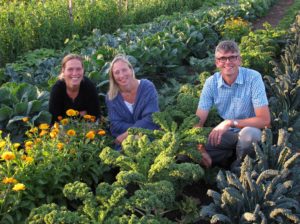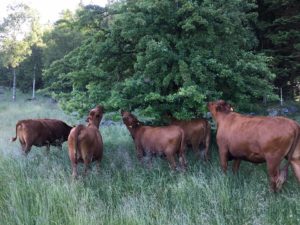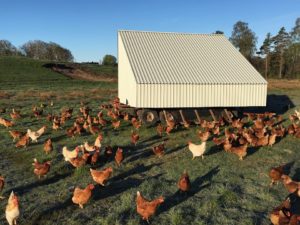News
Future of farming #1 – Build topsoil with Carbon farming

Can a farm with cows, chickens and vegetable production create a positive footprint on climate and ecosystems? Yes … This is part 1 of a series on agriculture of the future, we visit some of the Nordic countries’ most innovative innovative agriculture.
We regularly share farm inspiration and have written about everything from greenhouse farming above the Arctics to social farming projects in refugee camps in Hamburg. But we feel it is now time to give an overview of the future of agriculture and what needs to be done to tackle our climate challenges and other fate issues. So lets get started! First of all, we thought of raising an example of regenerative agriculture – also known as carbon farming. Last Sunday we visited two regenerative farms with the ambition to net-store carbon dioxide from the atmosphere and build up our food soils and in this blog you will learn about the meaning of regenerative agriculture based on their business. Let’s go!
Building topsoil is the most important issue of our time!
One of our major challenges in the conventional way we produce food is that it depletes our food soils.
Over the past 40 years, development has gone so far that we have now lost 2/3 of all food land and every year we are losing agricultural land corresponding to one area in the whole of Great Britain.
The food soil contains mud or so-called organic matter (OM) which consist of 50% carbon. Sure, but how is that soil organic matter created? Well, the process that nature builds this is through the roots of plants and by growing and keeping grazing animals properly, one can thus create a net storage of carbon dioxide while creating muddy soil that holds both more water and nutrients.
Did you know that there is more carbon dioxide stored in our soils than in both the atmosphere and the biosphere? In fact, we can absorb enough of the air’s CO2 in our soils to prevent climate change!
In the following video you will get an overview of how the earth and climate issue are related and what we must do to seriously prevent global warming.
Farms that build topsoil also capture carbon dioxide
Last Sunday we were on a study trip as part of the project Pre-study Andelsjordbruk. We visited Kyrkbygård which became KRAV certified 18 years ago. But according to Jesper who runs the farm, organic is not good enough. Since this year they have been practicing plow-free so-called “regenerative” agriculture, which builds the soil content in the soil and at the same time stores carbon dioxide from the atmosphere!
You can build meter-deep soils with a soil content of 5-10% instead of today’s soils which usually at most have about 25cm deep roots with 1% soil content.
“If every farmer in the United States would practise this system, in fewer than 10 years we would sequester ALL the CARBON that’s been emitted since the beginning of the Industrial Age…”
We will upload a little video from the farms where we explain a little about what regenerative farming means. Feel free to subscribe to our youtube channel so as not to miss the video when it comes out!
Pictures from Kyrkbygård and their various activities
How does this work then? Can’t the cows actually be good for the climate?
With 31 hectares of land area at Kyrkbygård, the main production is grassland, grazed by Holistic Management with cows and chickens in egg mobile on green pastures, moved daily. With manure from the cows, a so-called “no dig” market garden was built up of 1000 sqm with 600 sqm of efficient cultivation area that can create a half-time income of six months! NO DIG, is just what it sounds like – you don’t dig or turn the soil, instead you add a deep layer of mulch like compost of manure – and in this way it becomes much less weeds. The only thing you need to do is apply enough manure or compost when you build your farm and then continuously.
In this way, we create a positive spiral where the soil automatically binds more and more carbon dioxide and builds topsoil over time.
All these activities are related, the cows graze down the grass just when it has grown to the largest, leaving 40% of its growth which is trampled down to become organic material. Their cow poop stimulate micro life and by having a large animal on a small area and then letting the soil rest long enough, in this way you can build up the soil organic matter for each year.
A pioneer: Ridgedale Farm
Last summer we visited the farm which has been a great inspiration for many regenerative farmers, namely Ridgedale farm in Värmland. On both Ridgedale and Kyrkbygård, you have both cows grazing, tree rows of 16-25 meters. This system of integrating trees and grazing is a type of “agroforestry” practice – were you have the same grass growth but can also get the benefits and yields from the trees – that can eventually provide nuts and fruits. After the cows come the egg mobiles with chickens that also eat the grass and encourage carbon to be captured and build soil. Learn more about Ridgedale’s various regenerative farming enterprises that can actually be profitable at the same time as they are building soil. Check out our interview with Richard Perkins:
Wait a minute now .. Did you say Egg-mobile? What does it mean??
Well, it’s very exciting. However, it is not about the hens having their own smart-phone, but more about the hen house that can be moved around.
Here’s how it is: Chickens are normally kept indoors today and even though the chickens are said to be “free range” they usually only have “access to outdoor areas” where it is often so crowded indoors so it is still very difficult to get out. But with an egg mobile, the chickens can be out on green pastures all summer, which saves a lot of feed and makes the eggs more nutritious (you can actually see that the eggs have more yellow yolks).
In holistic pasture planning, you move the animals so often that the animals are not on the same surface for more than 3 days, otherwise you will easily deplete the roots of the grass by grazing on the new small, thin grass leaves that emerge immediately after 3 days.
Therefore, the chicken is moved every other day approximately to always have new fresh grazing and thus the chicken house is built on wheels.
At Ridgedale, as well as Kyrkbygård, you let the chickens follow the cows – so that just as in nature they can eat the larvae that hatch in the cattle’s crap. The cows and chickens also provide fertilizer in the winter which becomes compost for vegetable cultivation and builds up its fertility. To show a little about how a chicken cellphone works, we did an interview last year at Ridgedale focusing on the chickens.
Yep, that was all for this first part of the Agriculture of the Future .. Now don’t forget to share this article with your friends so we can inspire more to start building food soil in our elongated country!
PS: We also offer cultivation land for those who want to start growing!
And for those who want to take the step to start growing with these methods, we also have the cultivation land that we match through GrowGbg. Check out www.growgbg.com/land to see if there are land areas near you. Or why not share arable land if you are sitting on a plot near the town or a larger area in the countryside. Our goal is to facilitate more regenerative cultivation and we are happy to help you find growers for your unused land.
Follow us on Facebook and Instagram and subscribe to our newsletter so you don’t miss any new updates!
See you soon!
/Jonathan






